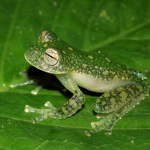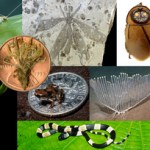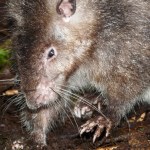new species
By now you have probably seen the video showing the discovery of a strange purple blob during an exploration off the coast of California. As a scientist what do you do when you find something new? You bring it back to the lab of course. Although it may take years to identify what it is, the researchers have speculated it might be some new species of soft-bodied mollusk. Check out the newly uploaded YouTube video:
NOAA image of a possible new species of octopus discovered near Hawaii. Photo credit: AP, NOAA
Scientists from the National Oceanic and Atmospheric Administration (NOAA) think they have discovered a new species of octopus while exploring the ocean floor around Necker Island (near Hawaii). The octopus was found 4,290 meters deep. Interestingly, fins were absent from the pale octopus, which NOAA scientist Michael Vecchione noted was unusual for an octopus living at that depth. Moreover, its suckers were found to be in a single row on each of its arms, as opposed to two rows.…
I really never thought of spiders as being "pretty" until I came across these two new species of peacock spiders discovered in southeast Queensland, Australia by Madeline Girard (graduate student from the University of California, Berkeley, who is specializing in peacock spiders). Peacock spiders are not only beautiful, they also engage in elaborate dances during courtship.
According to a quote from Jürgen Otto (posted in Live Science), who was a co-author in the study, Skeletorus "looks dramatically different [from] all other peacock spiders known to date, making me think that this…
Researchers in Peru have discovered four new species of tiny so-called "glass frogs" (family: Centrolenidae).
Centrolene charapita: with the yellow splotches on its back, this species was aptly named after little yellow chili peppers. Their hindlegs also had fleshy little zigzag-like protuberances whose purpose is unknown.
Figure 4 from Twomey et al. Zootaxa, 2014.
Cochranella guayasamini: This species is mostly green with yellow encircling its eyes. Interestingly, the tadpoles begin as a reddish pink color. Since they live in streambeds that are low in oxygen, this coloration…
The top 10 new species discovered in 2012 has been announced by the International Institute of Species Exploration at Arizona State University.
Tope 10 new species discovered in 2012. Image from: International Institute for Species Exploration, Arizona State University
My favorites:
The adorable tiny frog, Paedophryne amanuensis, from New Guinea that is only 7mm (pictured above on a dime). It is currently considered the smallest living vertebrate.
Glow-in-the-dark cockroaches, Lucihormetica luckae, from Ecuador (top right in composite above). Consider them night lights. Species of…
The International Institute for Species Exploration at Arizona State University that has just come out with the top 10 new species of 2012! This is the 5th year they have come out with such a list. If you would like to nominate your favorite new species discovered in 2013, click here.
Here are my favorites from the 2012 list:
The snub nose monkey (Rhinopithecus strykeri) from Myanmar that sneezes when it rains:
Photo reconstruction credit: Thomas Geissmann / Fauna & Flora International)
The Spongebob Squarepants sponge (Spongiforma squarepantsii), just because I LOVE that cartoon…
On Greg Laden's Blog, we learn that "a subspecies of 'Black Rhino' also known as the 'browsing rhino'" has gone extinct in Africa, while Northern White Rhinos and Javan Rhinos have likely met the same fate. Dr. Dolittle says the last known Javan rhinoceros in Vietnam was found "with its horn cut off, most likely a victim of poachers. Another subspecies, The Indian Javan rhino (R. sondaicus inermis), is believed to have gone extinct in the early 20th century." Fifty individuals still linger in West Java, and thousands of White Rhinos still roam in Africa, but on the whole this family is…
tags: Of Venom and Silk, arachnids, spiders, new species, endangered species, NYC, New York City, AMNH, American Museum of Natural History, streaming video
Spider biologist Norman Platnick, from the American Museum of Natural History, has traveled the world cataloguing some of these creatures, many for the first time ever. World renowned for his work, he hopes to find as many as species as possible before some disappear.
Asphinctopone pilosa Hawkes 2010
The discovery of new insect species continues apace. Today, the online journal Zootaxa presents this pretty little ponerine from Tanzania, described by Peter Hawkes.
Asphinctopone is a rather poorly-known genus previously collected only in the tropical forests of West Africa. Asphinctopone pilosa is larger than the other described species and the first record from East Africa, extending the range of the lineage thousands of kilometers to the east.
source: Hawkes, P.G. 2010. A new species of Asphinctopone (Hymenoptera: Formicidae: Ponerinae) from Tanzania.…
Myrmicocrypta camargoi Sosa-Calvo & Schultz 2010
Brazil
The world's ant fauna continues to yield new treasures. Myrmicocrypta camargoi, described in a new paper by Jeffrey Sosa-Calvo & Ted Schultz, is the largest species in this fungus-growing genus.
source: Sosa-Calvo, J., Schultz, T.R. 2010. Three Remarkable New Fungus-Growing Ant Species of the Genus Myrmicocrypta (Hymenoptera: Formicidae), with a Reassessment of the Characters That Define the Genus and Its Position within the Attini. Annals of the Entomological Society of America 103(2):181-195.
doi: 10.1603/AN09108
artwork by…
tags: researchblogging.org, new species, insects, American cockroach, Periplaneta americana, DNA barcoding, Brenda Tan, Matt Cost, Mark Stoeckle, Rockefeller University, American Museum of Natural History, AMNH
Mystery cockroach found in NYC apartment.
Image: Brenda Tan and Matt Cost.
Moving overseas has been a challenge, but worst of all for me has been the fact that my writing has suffered. I still read scientific papers and science news stories, but have been unable to find the time necessary to write these stories for you. Hopefully, my life is returning to some semblance of…
tags: new species, biology, botany, orchid, tiniest orchid, Orchidaceae, Platystele, Lou Jost
A close-up of the world's smallest orchid, at just over 2mm from petal tip to petal tip.
Image: Lou Jost.
The world's smallest orchid was discovered recently in a mountainous nature reserve in Ecuador by American botanist Lou Jost. Dr. Jost, a former physicist, now works as a mathematical ecologist, plant biogeographer and conservation scientist, and is one of the world's most expert orchid hunters. In the previous decade, Dr. Jost discovered 60 new species of orchids and 10 other new plant…
What? Another species?! I thought we were close to being done.
Thanks to Dr. Marshall for the photo
While traipsing through the Magombera forest in east Tanzania, Dr. Andy Marshall spotted a helpless little creature being eaten by a twig snake. With the courage and strength often associated with ecologists, Dr. Marshall rescued a new species of chameleon from the jaws of certain death. Well, actually he and his team startled the snake, causing it to drop the chameleon where Marshall's team then picked it up.
Dr. Marshall and his cohort Michele Menegon named the species Kinyongia…
Tetraponera merita Ward 2009, Madagascar
Tetraponera merita Ward 2009 is one of many aculeate species described in the pages of a new festschrift honoring Roy Snelling. I can't link to it, unfortunately, as the festschrift is printed the latest issue of the paper-only Journal of Hymenoptera Research.
All the same, if you can get your hands on a copy the effort is worth it, especially for a touching biography penned by Jack Longino and Roy's son, Gordon Snelling. The festschrift also holds a couple dozen articles spanning the ecology, chemistry, evolution, and systematics…
As you all probably know by now, we here at Zooillogix do not officially consider a species to exist until it is discovered by Western (or at least Western-trained) scientists. Here are some species that now, officially, exist for the first time.
The 3-foot long Bosavi woolly rat is "quite a handsome beast," Kristofer Helgen of the National Museum of Natural History, told National Geographic. It can be found around Mount Bosavi in Papua New Guinea.
The Kuranda tree frog speaks in a quick tap, leading researchers to name it the "fast talking frog." It lives in the tropical Queensland,…
Doesn't "bigote" mean "moustache" in Spanish?
Why, yes. It does.
Pheidole bigote Longino 2009
Chiapas, Mexico
The inimitable Jack Longino published a taxonomic paper today on the Central American Pheidole, including descriptions of some 23 new species. Among these is the marvelously moustached P. bigote. The function of the fantastic facial hair remains unknown.
source: Longino, J. T. 2009. Additions to the taxonomy of New World Pheidole (Hymenoptera: Formicidae). Zootaxa 2181: 1-90.Â
A new species of dolphin dubbed the snubfin has been witnessed displaying some very unusual feeding behavior off the northern coast of Australia. Apparently the dolphins were witnessed chasing fish to the surface of the water and then streaming jets of water out of their mouths to round the fish up before eating them.
I'm more of a Copenhagen mammel, myself.
"This incredibly unusual behavior, first seen in Australia off the Kimberley Coast, has only been noted before in Irrawaddy dolphins, which are closely related to this species," Lydia Gibson of WWF Australia told the Northern Territory…
tags: microbiology, astrobiology, new species, Indian Space Research Organization, bacteria
Bacterial colonies.
Image: Hub Testing Laboratory [larger view].
According to a recently published press release, three new species of bacteria have been discovered in the upper stratosphere by Indian scientists in an experiment conducted by the Indian Space Research Organization (ISRO). This discovery lends some credence to the hypothesis that life might have originated elsewhere in the cosmos and was seeded on Earth after colliding with a foreign body, perhaps a comet or asteroid, that was…
tags: new species, Papua New Guinea, Zoology, Biodiversity
A large brilliant green tree frog, Nyctimystes species, with enormous eyes, was discovered by scientists next to a clear-running mountain river.
Image: Steve Richards/Conservation International.
A brilliant green tree tree frog with giant black eyes, tentatively classified as a Nyctimystes species, is one of 56 new species of animals discovered during a 2008 expedition to the remote island of Papua New Guinea.
This species of frog is specially adapted to its habitat of rushing freshwater rivers: females lay their eggs underneath…






